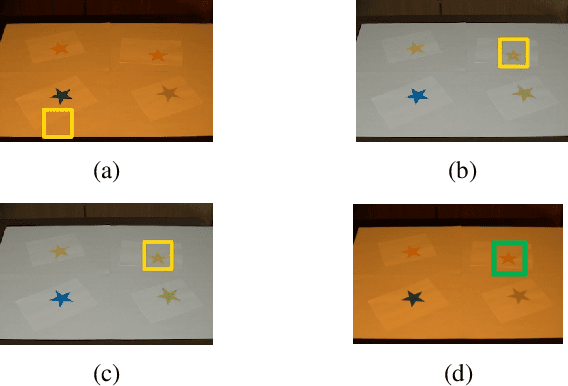Teruaki Akazawa
Template matching with white balance adjustment under multiple illuminants
Aug 03, 2022



Abstract:In this paper, we propose a novel template matching method with a white balancing adjustment, called N-white balancing, which was proposed for multi-illuminant scenes. To reduce the influence of lighting effects, N-white balancing is applied to images for multi-illumination color constancy, and then a template matching method is carried out by using adjusted images. In experiments, the effectiveness of the proposed method is demonstrated to be effective in object detection tasks under various illumination conditions.
Spatially varying white balancing for mixed and non-uniform illuminants
Sep 03, 2021



Abstract:In this paper, we propose a novel white balance adjustment, called "spatially varying white balancing," for single, mixed, and non-uniform illuminants. By using n diagonal matrices along with a weight, the proposed method can reduce lighting effects on all spatially varying colors in an image under such illumination conditions. In contrast, conventional white balance adjustments do not consider the correcting of all colors except under a single illuminant. Also, multi-color balance adjustments can map multiple colors into corresponding ground truth colors, although they may cause the rank deficiency problem to occur as a non-diagonal matrix is used, unlike white balancing. In an experiment, the effectiveness of the proposed method is shown under mixed and non-uniform illuminants, compared with conventional white and multi-color balancing. Moreover, under a single illuminant, the proposed method has almost the same performance as the conventional white balancing.
Multi-color balance for color constancy
May 21, 2021



Abstract:In this paper, we propose a novel multi-color balance adjustment for color constancy. The proposed method, called "n-color balancing," allows us not only to perfectly correct n target colors on the basis of corresponding ground truth colors but also to correct colors other than the n colors. In contrast, although white-balancing can perfectly adjust white, colors other than white are not considered in the framework of white-balancing in general. In an experiment, the proposed multi-color balancing is demonstrated to outperform both conventional white and multi-color balance adjustments including Bradford's model.
 Add to Chrome
Add to Chrome Add to Firefox
Add to Firefox Add to Edge
Add to Edge